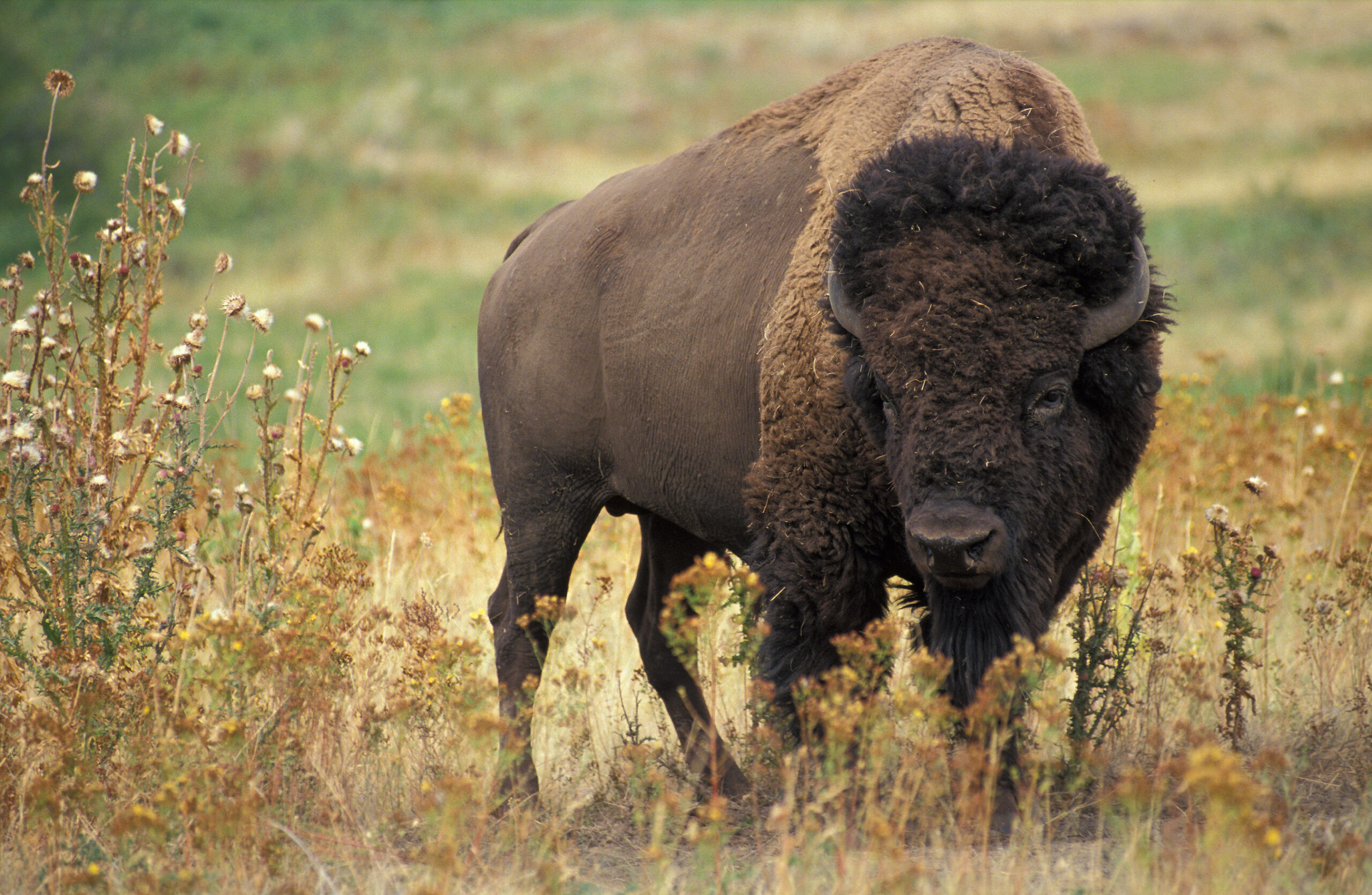
The American Bison, often referred to as the American Buffalo, holds a unique place in the history and culture of the United States. These massive and majestic creatures have roamed the vast plains of North America for centuries, serving as a symbol of strength and resilience. From their near-extinction in the 19th century to their resurgence as a conservation success story, the American Bison’s story is one of survival against the odds. In this exploration, we delve into 25 fascinating historical facts and numerical trivia about these iconic animals, shedding light on their ecological importance, cultural significance, and the tireless efforts to ensure their continued existence in the wild.
Scientific Name: The American Bison, scientifically known as Bison bison, is a fascinating species that has deep historical and ecological significance in North America. This species is part of the Bovidae family and shares its ancestry with the European Bison, which is the largest terrestrial animal on the continent.
Population Decline: One of the most tragic chapters in American conservation history is the steep decline of the American Bison population. At one point, these magnificent creatures roamed the plains in vast numbers, serving as a vital resource for indigenous peoples and early settlers alike. However, the 19th century saw a cataclysmic decline in their numbers due to unregulated hunting, which nearly drove them to extinction. By the late 1800s, only a small fraction of the once-thriving population remained.
Resurgence: The survival of American Bison can be largely attributed to the establishment of Yellowstone National Park in 1872, where a small remnant population found refuge. This marked the beginning of a concerted effort to protect and rebuild the bison population. Yellowstone’s bison herds are now some of the most iconic and well-studied in the world.
Height: Standing at an impressive 5 to 6.5 feet (1.5 to 2 meters) at the shoulder, American Bison are among the largest terrestrial mammals in North America. Their towering stature is a testament to their adaptation to the vast open spaces of the Great Plains.
Weight: Adult male bison can weigh between 1,000 and 2,200 pounds (450 to 1,000 kilograms), while females are generally smaller, ranging from 800 to 1,000 pounds (360 to 450 kilograms). These massive creatures possess remarkable strength and stamina, enabling them to thrive in challenging environments.
Largest Bison: “Old Reliable,” a legendary American Bison, holds the record as the largest ever recorded. This colossal individual weighed around 2,800 pounds (1,270 kilograms). The existence of such enormous bison showcases the astonishing diversity within the species.
Speed: Despite their massive size, bison are surprisingly agile and can sprint at speeds of up to 35 miles per hour (56 kilometers per hour). This agility was essential for evading predators in their natural habitat.
Lifespan: In the wild, American Bison typically live for 10 to 20 years, depending on various factors such as food availability, predation, and environmental conditions.
Historical Range: American Bison once dominated the landscape of North America, from the frigid tundra of Alaska to the arid deserts of Mexico, and from the Rocky Mountains to the lush eastern woodlands. Their range was astonishingly vast and encompassed diverse ecosystems.
Bison Hunted by Native Americans: Native American tribes revered the bison for its vital role in their culture and subsistence. These resourceful peoples hunted bison for thousands of years, using nearly every part of the animal for food, clothing, shelter, and tools. The bison was central to their way of life and spirituality, and they conducted communal hunts that honored and celebrated the buffalo’s sacrifice. These hunts played a critical role in shaping the ecosystems of the Great Plains and fostering a deep spiritual connection between indigenous peoples and the land.
Role in Indigenous Cultures: The American Bison played a profound and multifaceted role in the cultures of many Plains Indian tribes. For these indigenous peoples, the bison was more than just a source of sustenance; it was a symbol of life and an embodiment of spiritual significance. The bison provided not only food but also materials for clothing, shelter, and tools. Tribes like the Lakota, Cheyenne, and Blackfeet held elaborate rituals to honor the bison and sought visions or dreams related to these revered animals. The buffalo’s existence was closely tied to the well-being of indigenous communities, and its decimation had devastating consequences for their way of life.
Buffalo Soldiers: The term “Buffalo Soldiers” is historically associated with African American troops who served in the western frontier following the American Civil War. These soldiers earned this nickname from Native American tribes, who likened their dark, curly hair to the buffalo’s mane. Buffalo Soldiers played a pivotal role in the protection of settlers and infrastructure in the untamed west, contributing to the stabilization of the region during a tumultuous period.
Teddy Roosevelt’s Role: President Theodore Roosevelt is renowned for his instrumental role in the conservation movement in the United States. He helped protect the American Bison by establishing wildlife refuges and national parks, including the establishment of the National Bison Range in Montana in 1908. His actions laid the foundation for the recovery of the bison population.
Bison as a Symbol: The American Bison is a symbol of strength and endurance. It is fitting that this iconic animal is featured on the seal of the U.S. Department of the Interior, which is responsible for the management and conservation of many of the country’s natural resources and wildlife.
Repopulation: The early 20th century marked a turning point for American Bison conservation. With dedicated efforts and successful breeding programs, the bison population began to recover. The conservation success story demonstrates what can be achieved when concerted efforts are made to save a species from the brink of extinction.
Current Population: As of my last knowledge update in September 2021, the American Bison population had rebounded to over 500,000 individuals. This recovery represents a remarkable conservation achievement, although it’s crucial to continue efforts to ensure the long-term health of bison populations.
Yellowstone Bison Herd: The Yellowstone National Park is home to one of the most significant and oldest bison herds in the United States. This herd is a testament to the enduring resilience of the species and the importance of protected habitats.
National Mammal: In 2016, the American Bison was designated as the national mammal of the United States through the National Bison Legacy Act. This recognition underscores the cultural and ecological significance of the species to the nation.
Conservation Status: While American Bison are no longer considered endangered, they remain a species of conservation concern. The focus has shifted from saving the species from extinction to ensuring genetic diversity and preserving critical habitats.
Bison Farming: Bison ranching and farming have gained popularity due to the demand for lean and healthy meat products. Bison meat is lower in fat and cholesterol compared to beef, making it an appealing choice for health-conscious consumers. Bison ranching also contributes to the economic sustainability of bison conservation efforts, ensuring a future for these magnificent creatures.
Horns: One distinguishing feature of American Bison is their distinctive horns, which both males and females possess. Males, known as bulls, typically have larger and more massive horns compared to females, called cows. These horns are not only used for defense but also for digging through snow to access vegetation during harsh winters.
Record Horn Size: The largest bison horn span on record is an astonishing 40 inches (102 cm). This remarkable size showcases the variability within the species and the potential for individual bison to grow exceptionally large and impressive horns.
Bison vs. Buffalo: Despite the common use of the term “buffalo,” it’s important to note that American Bison are not true buffalo. True buffalo, such as the African buffalo and the Asian water buffalo, are distinct species native to other parts of the world. The term “buffalo” was likely a misinterpretation by early European settlers who equated the bison with the Old World buffalo.
Bison in Art and Culture: American Bison have left an indelible mark on American art, literature, and culture. Artists like George Catlin and Charles M. Russell depicted bison in their paintings, capturing the spirit of the American West. Bison have also appeared in countless novels, films, and historical accounts, shaping the way people perceive the frontier era and the vital role bison played in it.
Changing Conservation Status: As of my last knowledge update in September 2021, the American Bison’s conservation status had improved significantly. However, it’s important to note that conservation statuses can change over time due to various factors, including habitat loss and climate change. To ensure the continued success of bison conservation, it’s crucial to stay updated with the latest information and support ongoing efforts to protect this iconic species.








